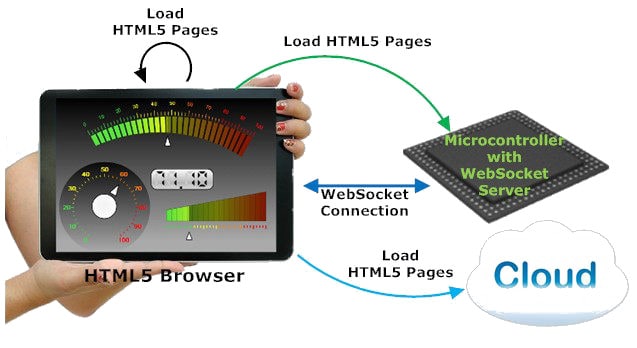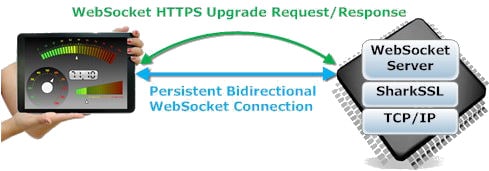
Minnow Server, a super small and fast embedded HTTPS (secure) WebSocket server, lets small microcontrollers with no external memory act as real-time web servers. The super small and secure Minnow Server is ideal for devices that are too small for standard web applications or our Barracuda Embedded Web Server.
The Minnow Server is available under either an open-source license or a commercial license. The Minnow Server is also included as a free optional component in the SharkSSL package. The open source licensed version is available on Github.
The Minnow Server is designed for memory-constrained microcontrollers such as Cortex M3. We recommend using the Embedded App Server for larger embedded systems.
Minnow Server incorporates the HTML5 WebSocket specification, letting JavaScript applications open a persistent, bidirectional, full-duplex, and asynchronous communication channel with the embedded device. The Minnow Server is specifically designed to facilitate the use of modern Single Page Applications (SPA) for device management and can be used with modern frameworks such as AngularJS, ReactJS, and Vue.js. See the video below for details.

The Minnow Server is ideal for most modern microcontroller-based systems, letting you web-enable even the tiniest device.
Web applications for Minnow Server are designed in JavaScript and can load on demand from any of the following:
You decide where to store the web presentation logic by selecting one or all of the above options. Of course, the benefit of storing the web presentation logic off the device is that it saves considerable space on the device and lets you easily modify the application without upgrading the firmware.
When we say size, you are probably thinking of the Minnow Server C code, and yes, the server's code size is small; however, we are referring to the web application you will design. Did you know that modern web applications can easily be megabytes in size, especially if using modern tools such as Angular and React? Our Minnow Server design book shows how to design a compact fully, fledged Single Page Application suitable for microcontrollers. In addition, the Minnow Server stores compressed data and serves the data to the browser without having to uncompress the data, further reducing the web application size by one-third. Both the Minnow Server and our Barracuda App Server store web applications compressed, embedded in the firmware, on a separate memory partition, or on a file system.

The Minnow Server is one of three WebSocket server implementations provided by Real Time Logic.
The Minnow Server is designed for embedded devices, but you may initially want to try our ready-to-use reference example on your host computer. The following instructions work on Windows 10 with the Linux subsystem, Linux, and Mac OS. Check out the sharkSSL IDE if you want to easily test the Minnow Server Reference Example in secure mode (HTTPS). See the tutorial Beginner's Guide To Embedded Systems and Secure IoT Communication for details.
Open a shell and copy/paste the following into the shell to make sure you have the necessary tools.
Copy and paste the following into the shell to download and compile the Minnow server reference example with the optional IoT bridge mode.
When the server runs, control the server by navigating to http://localhost:portno or via the online IoT bridge demo server. Log in with user 'root' and password 'password'.
Download Minnow Server from GitHub and start writing Minnow Server Apps. Our Minnow Server design book shows you how to easily and efficiently develop web applications for microcontrollers without running into the typical issues related to running a web server on a resource-constrained device.
The following video shows how to install the reference example on a FreeRTOS/lwIP-powered ESP8266.
The Minnow Server comes pre-integrated with our own TLS stack, SharkSSL, thus making it easy for you to use as a developer.

You may think you do not need a TLS-enabled and trusted server when deployed on a private network, but nothing could be further from the truth. Learn how shockingly easy it is to hack servers on private networks with free tools available on the Internet.

The WebSocket protocol defined in RFC 6455 specifies how a standard HTTPS request/response pair can be upgraded to a secure and persistent full-duplex connection. HTML5 WebSocket-based applications enable real-time communication while placing less burden on the servers.
WebSockets is a relatively new standard that brings real-time communication to the web. WebSockets is supported by all modern browsers and is designed to provide a persistent full-duplex asynchronous communication channel over a single TCP connection.
| HTTP | WebSockets |
|---|---|
| Persistent | |
| Partly | Yes |
| Duplex | |
| Half | Full |
| Message Pattern | |
| Request-Response | Bi-Directional |
| Service Push | |
| Not supported | Core feature |
| Overhead | |
| Moderate to large for embedded systems | Minimal overhead per WebSocket message |
Most embedded web device management applications currently operate by simply responding to user interactions. You click a button, and this causes the browser to submit the data to the server. The server performs the command and responds with a new HTML page. This old technology works, but it is a very limiting model. You may have moved beyond the simple GET/POST submit button web design concept and embraced AJAX/REST. However, the fact remains that AJAX is still a one-way asynchronous message sent from the browser to the server, and any real-time updates you want to display in the browser require polling of server resources. You may still think AJAX and REST are the way to go; however, the entire AJAX protocol could be built using Websockets technology. This makes WebSockets literally a superset of AJAX, so it makes sense that we might abandon a limiting technology for a broader technology.
The fact that WebSockets provides a bi-directional communication channel between the browser and server immediately opens up some exciting opportunities for web-based device management applications. Because the connection is persistent, the embedded web server can now initiate communication with the browser. The embedded web server can send alerts, updates, notifications, etc.. This adds a whole new dimension to the types of web-based device management applications that can be constructed.
You may have an application where AJAX is the preferred communication model. WebSockets enables us to multiplex data on the same connection; thus, we can quickly implement an AJAX library on top of WebSockets and still use the same WebSockets connection for bi-directional real-time data transfer. See our AJAX over WebSockets tutorial if you are interested in learning more about this technique.
The Minnow Server is primarily designed for small microcontrollers such as the Cortex-M3/M4 family, where internal memory is limited, and using a full application server, such as the Barracuda Application Server, is not an option. Minnow Server is not recommended for larger embedded systems where a full application server can fit into the memory.
Out-of-the-box operating system (OS) support includes INTEGRITY, MQX, SMX, Azure RTOS, embOS, VxWorks, QNX, FreeRTOS, uCLinux, MDK-ARM, Microchip, mbed, Mediatek, lwIP, Linux, and Windows™.
Out-of-the-box support for lwIP in event-driven mode.
Consider using the Barracuda App Server with its included WebSocket libraries if you are using a microprocessor or a microcontroller design with included external SRAM. To learn why check out the Web server vs. Application Server Tutorial.
Barracuda App Server running on the ESP32 microcontroller; right pane showing the Xedge Lua IDE.